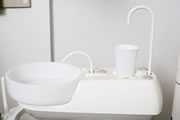Medical and Dental Equipment
Medical and Dental Equipment Connected to Main Water Systems
Certain pieces of medical and dental equipment can be directly connected to main water systems, including the automated endoscope reprocessor (AER) and certain dental units that are connected to water lines. It is highly important that these pieces of equipment use uncontaminated water during medical procedures. Certain microbes from water can contaminate medical equipment, causing nosocomial (hospital-related) infection and outbreaks of infection.
Automated Endoscope Reprocessor (AER)
An endoscope is a tube-like medical instrument used to examine the interior surfaces of the body. According to CDC's Division of Healthcare Quality Promotion and the Healthcare Infection Control Practices Advisory Committee (HICPAC), an endoscope is generally subjected to high-level disinfection using a liquid chemical sterilant or a high-level disinfectant. The optimal rinse fluid for this device would be sterile water; however, sterile water is expensive and difficult to produce in sufficient quantities. If sterile water is not feasible, water that has been passed through filters with a pore size of 0.1 – 0.2 microns would also be optimal as a rinse fluid for this device (1).
Water has been linked to the contamination of endoscopes through two scenarios:
- Rinsing a disinfected endoscope with unfiltered tap water, followed by storage of the instrument without drying out the internal channels (1)
- Contamination of the instrument from tap water inadvertently introduced into the equipment (1)
In order to avoid contamination, it is important to properly clean and disinfect these tools with sterile or filtered water, let them dry completely, and avoid further contact with unfiltered, untreated tap water.
Dental Units Connected to Water Lines

According to CDC's Division of Healthcare Quality Promotion and the Healthcare Infection Control Practices Advisory Committee (HICPAC), the water lines that feed many dental units deliver water during general, non-surgical procedures. Municipal tap water is usually the source for these lines. CDC recommends that all dental instruments that use water should be run to discharge water for 20-30 seconds after each patient and for several minutes before the start of each clinic day. This practice will help to flush out any patient materials that may have entered the waterlines (1).
For More Information
For more information on medical and dental equipment that are connected to main water systems, visit Guidelines for Environmental Infection Control in Health-Care Facilities [PDF - 1.36 mb] (pages 69-71) from CDC and the Healthcare Infection Control Practices Advisory Committee (HICPAC).
More information on hospital-based recommendations for medical uses of water is found at CDC’s Infection Control Guidelines (Division of Healthcare Quality Promotion).
Recommendations for Medical Equipment Connected to Water Systems
Recommendations for Environmental Infection Control in Health Care Facilities-Miscellaneous Medical Equipment Connected to Water Systems
Recommendations of CDC's Division of Healthcare Quality Promotion and the Healthcare Infection Control Practices Advisory Committee (HICPAC).
[This information was taken directly from page 21 of the MMWR report that can be found at http://www.cdc.gov/mmwr/PDF/rr/rr5210.pdf [PDF - 1.2 mb] ]
- Clean, disinfect, and maintain Automated Endoscope Reprocessor (AER) equipment according to the manufacturer’s instructions and relevant scientific literature to prevent inadvertent contamination of endoscopes and bronchoscopes with waterborne microorganisms. Category IB
- To rinse disinfected endoscopes and bronchoscopes, use water of the highest quality practical for the system’s engineering and design (for example, sterile water or bacteriologically-filtered water [water filtered through 0.1–0.2-µm filters]). Category IB
- Dry the internal channels of the reprocessed endoscope or bronchoscope using a proven method (for example, 70% alcohol followed by forced-air treatment) to lessen the potential for the proliferation of waterborne microorganisms and to help prevent biofilm formation. Category IB
- Use water that meets nationally recognized standards set by the EPA for drinking water (<500 CFU/mL for heterotrophic plate count) for routine dental treatment output water. Category IB, IC
- Take precautions to prevent waterborne contamination of dental unit water lines and instruments:
- After each patient, discharge water and air for a minimum of 20–30 seconds from any dental device connected to the dental water system that enters the patient’s mouth (for example, handpieces, ultrasonic scalers, and air/water syringe). Category II
- Consult with dental water-line manufacturers to:
- Determine suitable methods and equipment to obtain the recommended water quality; and
- determine appropriate methods for monitoring the water to ensure quality is maintained. Category II
- Consult with the dental unit manufacturer on the need for periodic maintenance of anti-retraction mechanisms. Category IB
Rating Categories
Recommendations are rated according to the following categories:
- Category IA
- Strongly recommended for implementation and strongly supported by well-designed experimental, clinical, or epidemiologic studies.
- Category IB
- Strongly recommended for implementation and supported by certain experimental, clinical, or epidemiologic studies and a strong theoretic rationale.
- Category IC
- Required by state or federal regulation, or representing an established association standard. (Note: Abbreviations for governing agencies and regulatory citations are listed where appropriate. Recommendations from regulations adopted at state levels are also noted. Recommendations from AIA guidelines cite the appropriate sections of the standards.)
- Category II
- Suggested for implementation and supported by suggestive clinical or epidemiologic studies, or a theoretic rationale.
- Unresolved issue
- No recommendation is offered. No consensus or insufficient evidence exists regarding efficacy.
References
- CDC and HICPAC. Guidelines for Environmental Infection Control in Healthcare Facilities. Available at http://www.cdc.gov/ncidod/dhqp/pdf/guidelines/Enviro_guide_03.pdf. [PDF - 1.4 mb].
Related Links
Here at CDC
- Infection Control Guidelines
- Dental Offices During a Boil Water Advisory
- Hospitals, Healthcare Facilities, and Nursing Homes during a Boil Water Advisory
CDC and the Healthcare Infections and Control Practices Advisory Committee (HICPAC)
- Page last reviewed: October 11, 2016
- Page last updated: October 11, 2016
- Content source:


 ShareCompartir
ShareCompartir